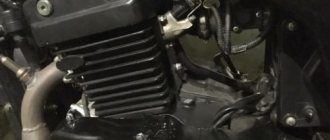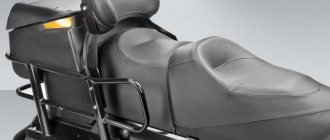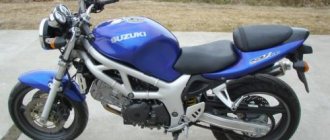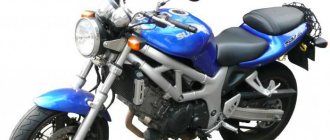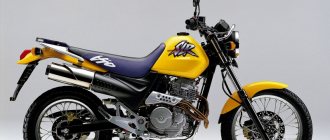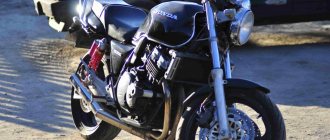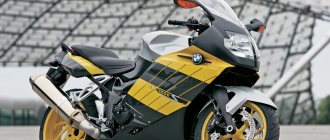What did Abramovich's purchase of the Chelsea football team cost the British? Another one buys TVR, another Formula 1 team Virgin Racing. National values are going under the hammer. But the pride of the British has not gone away. There are still heroes in the country! Triumph is one of the most modern and largest motorcycle companies in Europe
It’s not often that you see a purely English motorcycle on city streets. As for the streets of our city, here it is generally exclusive. But Triumph has represented the British motorcycle industry for more than a hundred years, which is why there is special interest in this bike. I've always associated Triumph with the classic motorcycles of the mid-twentieth century, built from steel tubes and rough duralumin alloy. In those days, England brought almost the entire motorcycle world to its knees, including in racing! Old school. And the British can also be considered the founders of the world-famous American chopper. In any case, Triumph played a significant role in the development of this class of motorcycles.
— This bike cannot be called elegant. But whoever says that the Daytona 600 is an ugly motorcycle, let him throw a stone at himself
Much water has flown under the bridge since that time. Triumph changed owners more than once, fell apart, rose to its feet, went bankrupt and rose again, burned and built itself up again. In general, the brand has a very rich history. And the current manufacturer, with the pride inherent in the British, looking back at the glorious past, keeps up with the times. Classic motorcycles of the old school are undoubtedly present in the line of produced models, but equipped with the latest “tourers” and technologically advanced sportsbikes are by no means Triumph’s weak side. This is confirmed by the merits of the Valmoto factory team, which takes part in Supersport class races in racing versions of Daytona. And the participation of the factory team in the championship speaks volumes, including advanced technologies, without which modern sport is simply unthinkable. It is no secret that developments that have proven themselves in racing cars are inherited by their civilian brothers. The Triumph Daytona 600 is no exception to this good tradition and is rightfully the heir to the team's best achievements.
— Triumph is a purebred “British” with excellent pedigree. This is the kind of motorcycle I want to own
Looking around the motorcycle, I pay attention to how the fairings are cut. They certainly correspond to modern fashion trends and perfectly fulfill their aerodynamic function. Despite the 2004 year of manufacture, the motorcycle still looks very impressive today. I would even say handsome! In the front part, the contours of the headlights with an inertial boost air intake are very harmoniously played out, which cannot leave anyone indifferent. The food, although large, does not seem like a fatty growth, but fits quite logically into the overall picture. In addition, the designers ergonomically used the provided volume of the rear part and placed almost all the electronic filling in it. And there is even room left for a small compartment under the rear seat, into which you can put something oversized. The seat can be opened simply with the ignition key.
In general, the Daytona 600 looks a little larger than its classmates. That’s right, it seems like there’s a whole “liter” in front of you. The massive exhaust pipe adds its own note to this misconception. Its essence is revealed only by the front fork stays, which are thinner than expected for a “liter,” and the 180-width rear tire.
Although the optics are beautifully designed, they do not contain any technological delights. Standard lights with standard lamps
By the way, the Daytona 600 has a regular front fork, while almost all of its classmates have an inverted one. European conservatism can be traced. Although it would be hard to call it junk wood. The fork has a full range of adjustments: spring preload, rebound damping force and compression damping force. You couldn't wish for more.
The rear suspension is not so advanced; the stock monoshock absorber has adjustments for spring precompression and rebound damping force. True, in the upper part of the shock absorber there is a special fitting for installing a remote oil reservoir, by installing which you can enjoy a full range of adjustments.
There is no remote shock absorber oil reservoir with adjustment in the stock and can be installed at will
The clutch release is not yet hydraulic, but it works very nicely and clearly
The braking system is advanced in a sporty way - four piston calipers in Triumph calipers on two floating discs at the front and a Nisin caliper at the rear.
So, sitting down on the Daytona, I find that my legs are quite comfortable, with my entire foot resting on the asphalt. And this despite an unremarkable height of 176 cm and 815 mm of saddle height, which, by the way, is quite wide and even comfortable. I immediately notice that the suspension is set up quite comfortably even for me, although the owner of the motorcycle weighs much heavier, about a hundred kilograms. My hands are on the steering wheel, but I’m still not bent, my feet are on the footrests, but I’m still comfortable. The seating position is more reminiscent of a sport-tourer.
Warm up the engine. The sound at idle, as befits a 600, is not too bassy, but at the same time quite impressive. It responds to the gas without the nervousness inherent in “sports.” It, of course, picks up speed instantly, but the tachometer needle drops with a slight delay, like a car. Something is wrong here. This thought does not leave me until I finally put the car in gear and set off.
From this very moment the device reveals its true face. Despite its daring appearance and sporting pedigree, the Triumph Daytona 600 turns out to be a very flexible and, one might even say, kind motorcycle. I never expected such friendliness. It drives, of course, excellently, the traction is quite confident, the acceleration is decent, and the tachometer needle without hesitation approaches the 14 mark (!), and so on gear after gear. Shifts are very clear, yet soft, without jerking or feeling like a terminator is recharging a tank in the gearbox, even if you don’t use the clutch!
The instrument panel is quite informative and easy to read. A small complaint about the turn signal indicator. But the electronic speedometer is very much on topic!
After driving a little, you realize that the engine is above 9,000 rpm and there’s not much point in turning it. The bottom and middle of the rev range produce excellent thrust until about 8-9 thousand, after which the engine does not seem to be slacking and willingly revs further, but the previous acceleration noticeably weakens, and the exhaust system begins to produce a hysterical sound, hinting: click the gears further. I suspect that the “top” was deliberately sacrificed for the sake of low and medium speeds. Although “switched on” people can correct this issue. Using a special scanner or a regular computer (an adapter is required) and if you have the appropriate program (it’s easy to get it on the Internet), you can conjure up the settings of the engine power control unit or simply download one of the offered ones. The potential of this in-line “four” is definitely not fully revealed.
By the way, injection is carried out by two nozzles for each cylinder, the second one is connected at higher speeds. This feeding pattern was called the “butterfly”.
You don’t even want to interfere with a comfortably tuned chassis and change anything. Unfortunately, we don’t have a special winding track, so we don’t have the opportunity to test the Daytona in real combat conditions. In the city, too, you can’t roam around: cars, signs, etc. And the comfortable, almost classic fit completely discourages the desire to turn this flexible motorcycle into a racing car with wooden blocks instead of shock absorbers. On the standard “snake” the motorcycle rolls over at speeds of up to 80 km/h without any complaints. Having accelerated a little faster, when entering the “snake” the motorcycle begins to get irritated and is not so willing to shift from side to side and at some point even tried to control me. Tried again - same story. If you reconfigure the chassis and make it stiffer, the situation should change for the better, but I don’t think that much. “Snake”, of course, is not a completely correct test for “sport”, but much slower and softer motorcycles passed it more willingly. It seems that a winding track with steep turns, where you have to often and sharply shift the motorcycle from one side to the other, is not the strongest side of the Triumph Daytona 600. At the same time, no one canceled the “knee-high” turns! And here’s another thing, if, for example, on other bikes of the “supersports” series, when you sit down, you immediately bend your torso towards the tank, then on the Daytona 600, in order to bend down, you need to bend your elbows quite a bit - not the best solution when maneuvering at high speed. Again, the lesser of two evils is chosen, and the designers decided in favor of comfort. So long runs will be possible not only for the Daytona, but also for the person who controls this motorcycle.
— For the Daytona 600, fast, long turns are closer in spirit
The windshield directs airflow over your shoulders, even when you're in a relatively straight-back position, which is the standard Daytona 600 position. The mirrors are far enough away from the head, thereby providing a good overview.
The legs are comfortable, as is the butt, and the feet do not confuse the controls with any other protruding parts of the motorcycle such as the side support or anything else, because they are located parallel to the ground. The clutch, although mechanical with a cable drive, is at the same time very soft and informative. Again conservatism, and again not to the detriment.
Affordable entry-level cruisers
Affordable entry-level cruisers
#1 Post by KSW » Sat Apr 26, 2014 14:06
Provocative title, isn't it?
However, when I accidentally saw an Irbis GARPIA 250, I fell out of this reality for a few seconds, forgetting what I had to do and what I was going to do, the exhaust “played” in my head, and my face felt a prickly stream of air. A second later I fell out again when I saw how much this motorcycle cost... and it cost 82,000 rubles for a new (NEW!!) motorcycle.
A small lyrical digression about how I started thinking about budget “Chinese bikes” (and not about the old Japanese, Soviet tanks, etc.) My motorcycle journey began from the moment when I, as a teenager, got to the motorcycle of my uncle, Minsk “macaque” 1987, remember this one?
I think there is no point in telling that it was with him that I learned many of the tricks and wisdom of motorcycle life, I went through it, then killed it, then went through it again, and so on until I entered the university. By the way, the motorcycle is still running, and the content of original parts tends to be 95%, but the appearance, unfortunately, reveals all the bitterness of the long, harsh life of the motorcycle.
So, it’s been 10 years since I sat on iron horses, my studies, my emergence as an adult and the beginning of my career were marked by a lack of money first, and then also time, those same sensations and memories of motorcycle driving faded and quietly lurked in the depths of my consciousness . And so, in 2013, my wife and I bought bicycles, and I again felt the thrill of traveling on two wheels (and I hadn’t ridden a bicycle for even longer), and the desire to ride a two-wheeled roar gradually returned.
In general, this is exactly how I calmed myself down when I heard the roar of motorcycle engines rushing past me while I was waiting for a trolleybus to take me to work.
Everything changed when I saw the prices for new motorcycles from the Middle Kingdom - 70, 100, 120 thousand rubles, isn’t it a fairy tale? Naturally, I started looking for scant reviews from owners and eyewitnesses of such motorcycles, in the hope of dissuading myself from buying one (oh, that feeling when there is only one word in your head “I want!” and you are trying to cool yourself down and look at things with a sober look, and not give in to emotions like a child). It turned out that in general, these motorcycles are not so bad, although the cubic capacity is small, the quality of materials can often raise questions, and the percentage of defects is much higher than that of famous brands.
But the advantages of such motorcycles are also obvious; if you are a beginner (and after a 10-year break, this is the only way I perceive myself) or are switching from another type of motorcycle, then a small cubic capacity is a good option to understand whether a motorcycle fits into your life, Is this particular type suitable, and the speed limits of such a motorcycle will make the process of awareness a little safer (before riding a thoroughbred, it would be a good idea to first saddle a colt).
Why not a Soviet or used Japanese motorcycle? To be honest, I don’t have much time to rebuild a motorcycle, as I did before with Minsk (and to be even more honest, I don’t have much desire anymore), a Soviet motorcycle lives indefinitely, but becomes your second wife or girlfriend (and with a rather bad character), but buying a pig in a poke with the Honda, Yamaha or Kawasaki logo, investing in it and expecting that you will have to shell out more at any moment is a dubious gain in peace of mind, and even more so a loss in price. And in the end - how nice it is to buy new shiny equipment, albeit without “antler” nameplates, but without chilled seats and unpleasant old age sores
